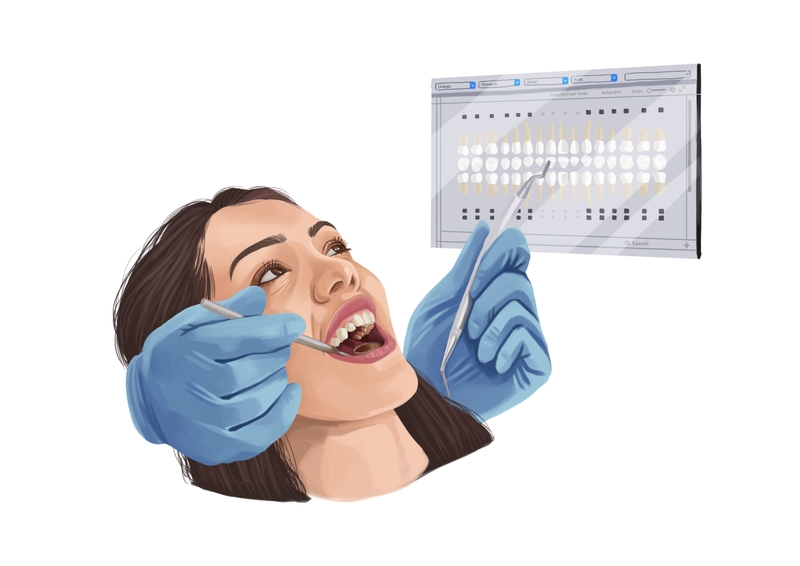- Tooth mamelons are small bumps on the edge of the front teeth that are a normal part of tooth development and do not cause problems. They usually occur on two or four front teeth, with each tooth having a group of three bumps.
- Mamelons form on the permanent teeth before birth. They help the teeth break through the gums.
- If you still have mamelons and want to remove them, your dentist can perform tooth recontouring or tooth reshaping.
Don't compromise on your dental care due to cost. Use Authority Dental to find low-cost dental care near you. It’s simple, secure and free.
Are you worried about having mamelons on your teeth? Here's everything you need to know.
Which teeth have mamelons?

Picture by Authority Dental under CC 2.0 license
Your permanent maxillary and mandibular incisors are where you will notice mamelons if you have them. They can form on both the central and lateral incisors, which are your four front teeth on either arch. More than 90% of people will see mamelons on their incisors when they erupt. However, they begin to wear down and become less noticeable, or even disappear completely, within just a few months of tooth eruption.
The mamelons appear on the incisal edge of the crown portion of your teeth. You will notice a group of three, rounded bumps on the adult teeth that give them a wavy edge.
Baby teeth (also called primary teeth) never have mamelons.
Why do mamelons occur?
Mamelons are the result of healthy teeth formation. Teeth develop during pregnancy and mamelons are the result of the merging of different formation processes. They are actually formed on your permanent (adult) teeth before you're even born and help your teeth break through the gum tissue when it's time to do so.
How to remove mamelons?
Lee explains: "Clinically, mamelons usually disappear through natural wear once the upper and lower teeth begin to meet and grind against one another. While nearly 90% of children start with them, they typically smooth out by the early teen years."
"If I see an adult with prominent mamelons, it is often a diagnostic "red flag" for a bite issue, such as an open bite. Since the teeth do not touch during chewing, those ridges never wear down, signaling an alignment problem that might need an orthodontic look," he warns.
If you do not like the way your teeth look due to mamelons, your dentist can easily remove them through tooth recontouring or tooth reshaping. Their removal is purely cosmetic, though your insurance provider might cover the treatment.
Your dentist will start by taking X-rays of your teeth to make sure it is acceptable to remove the mamelons. If they are too close to the dentin layer or the nerve, or if there is decay, other procedures may be required.
Once your dentist has decided you can proceed, the procedure is quick. No local anesthetic is needed, since only enamel is being removed. Your dentist will use a reshaping bur to contour your teeth based on your gender and the shape of your other teeth. Once the mamelons are gone, the enamel will smooth and polish.
Often, when an adolescent undergoes orthodontic treatment, the orthodontist can remove the mamelons from the incisor teeth at the time of brace removal. This is also a standard treatment option in pediatric dentistry.
Painless procedure, non-invasive, no downtime
Smoother teeth are easier to care for
Inexpensive
For minor changes only
Teeth may be sensitive for a short time
Too much removal could cause breaking or decay

FAQ
Do mamelons need to be removed?
Mamelons do not typically need to be removed, but in some cases, they can cause alignment issues that may require orthodontic treatment.
How long should mamelons last?
Mamelons first appear when the permanent incisors erupt, usually between ages six and eight. They can wear down quickly (within months) or take several years to go away.
Do bumpy teeth indicate a more concerning oral health problem?
If the bumps on your permanent teeth are mamelons, there are no serious oral health problems. Mamelons are a natural result of tooth formation. You can remove them with cosmetic contouring.
What is the difference between mamelons and ridges?
Some people use the terms ridges and mamelons simultaneously, but ridges can also refer to a normal, permanent feature of the biting surface of your teeth.
Harry Lee, DMD
I have seen many worried parents bring their children in, thinking their new adult teeth are "chipped" or "jagged." These ridges, called mamelons, are actually hallmarks of healthy development. They represent the different lobes of enamel that fused before the child was even born. I often describe them to patients as nature's "serrated edges," specifically designed to help the teeth break through tough gum tissue during eruption.